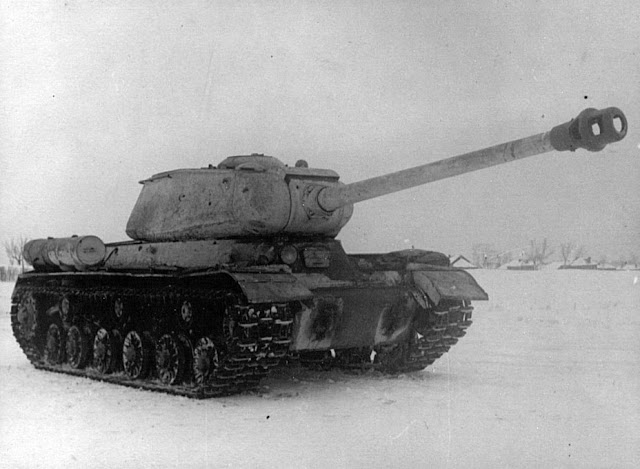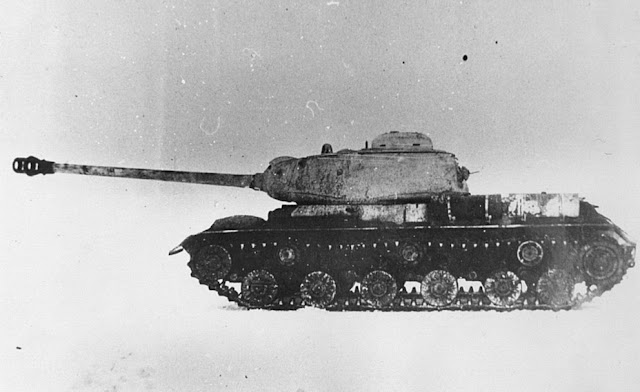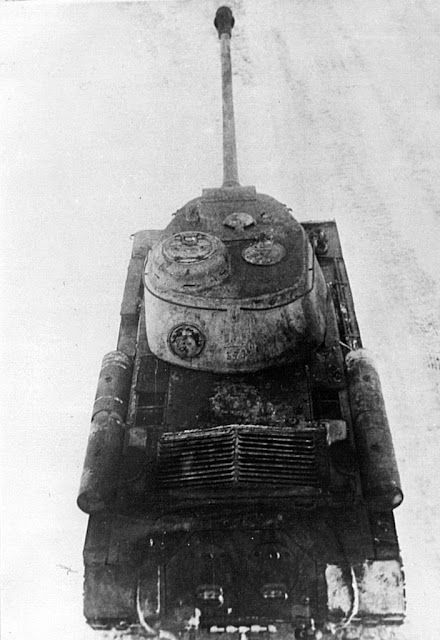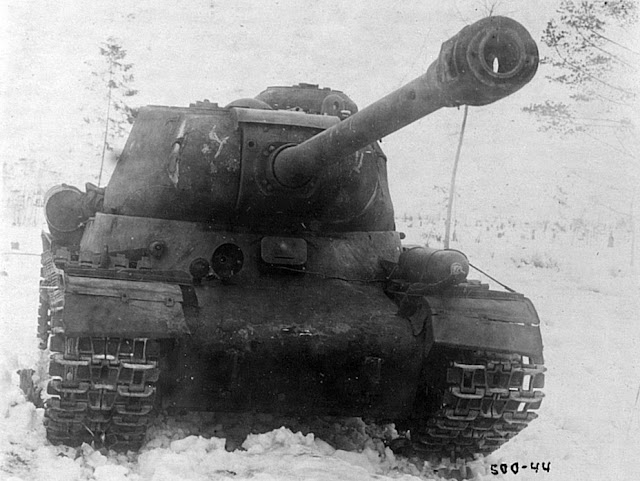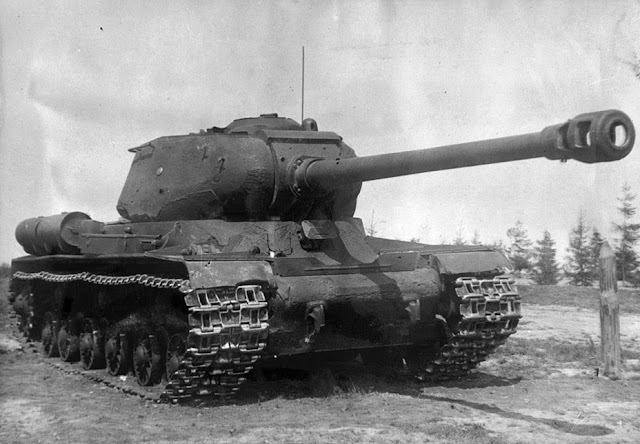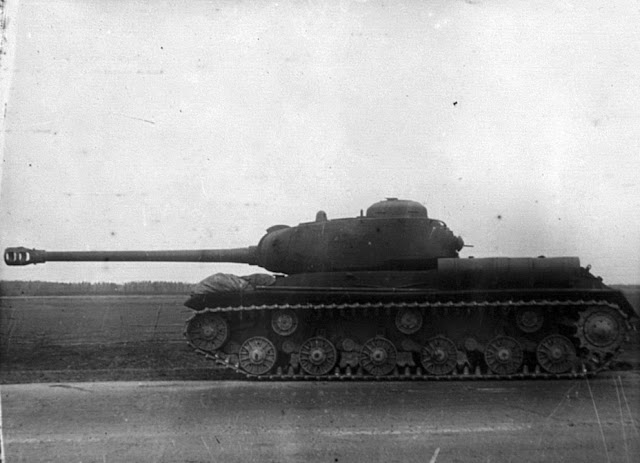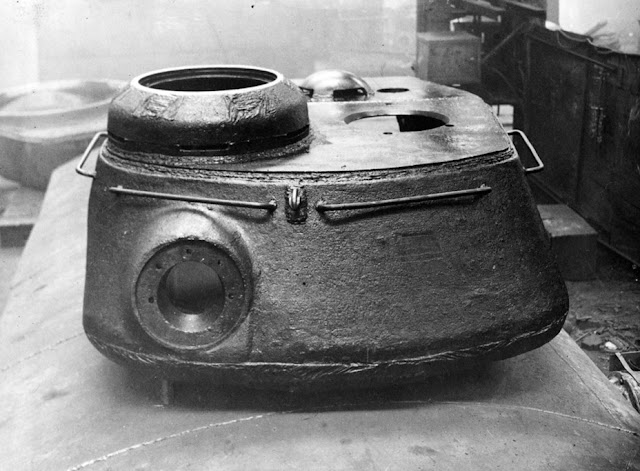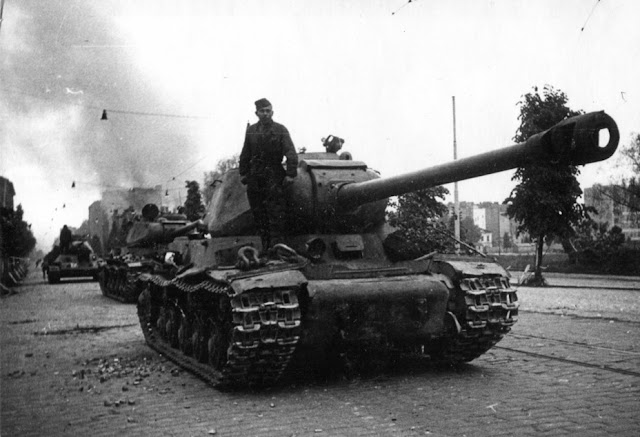The experimental Object 240 tank was accepted into service with the Red Army on October 31st, 1943. This was the end of the history of the KV, which started in 1939. The last touch applied to the new tank was the 122 mm D-25T gun, which was capable of defeating any German tank. Soviet designers did not only catch up to the German Tiger tank, but surpassed it. This article will cover the production of the IS-2 and development of its design from late 1943 to mid-1944.
Heavy tanks: a new priority for ChKZ
1943 was a difficult year for the Chelyabinsk Kirov Factory. Not a single tank factory in the world had to do what Tankograd went through. The factory built 6 types of tanks (KV-1S, KV-8S, KV-85, IS-1, IS-2, and T-34) and 2 types of SPGs (SU-152 and ISU-152) during this year. 3-4 types of tanks were being built in parallel.
It's hard to call this situation normal. ChKZ initially was built to focus on heavy tanks, but was tasked with production of the medium T-34 in the summer of 1942. The T-34 became Tankograd's main product in September of 1942. The volume of production increased, hitting its peak in October of 1943, when ChKZ delivered 366 tanks.
Cutaway diagram of the IS-2, December 1943.
The launch of the Object 240 into production under the name IS-2 was performed at a difficult time. The factory was also preparing the IS-152 (that was the initial name of the ISU-152) for production at the same time. In addition, the start of IS-2 production didn't mean that the factory would stop producing the IS-1 (IS-85). Both tanks were being built in parallel at ChKZ until January 1944. Even though the differences between the two tanks appear negligible at first, the difficult production situation was made even more complicated.
The first type of IS-2 turret, installed on production tanks from December 1943 to March 1944. The last tanks with this type of turret had a gun with a sliding breech.
A list of complaints regarding the placement of the crew in the fighting compartment was composed after trials of the Object 240 at the Gorohovets ANIOP (Artillery Research Proving Grounds). The commander was placed too close to the gun. The rear machinegun was removed after the larger gun was installed, since it was difficult to use. Some components installed on the roof had to be moved due to the larger gun. Finally, the gun mantlet (component 240-57-39) had to be changed. The turret (component 240-57-Sb.6) was similar to the IS-1 turret, but not identical.
IS-2 serial number 3124 tested at the NIBT proving grounds in late January-early February 1944.
The first variant of the turret was developed for the IS-122 at the factory #100 design bureau in mid-November 1943. The exhaust fan on the roof of the turret was moved back and to the right. The MK-IV periscope that the loader used was also moved back and to the right. The front roof slope was changed from 5 to 3 degrees. The loader's hatch was moved, and its torsion bar was reinforced. The commander's cupola was moved to the left, which required an expansion of the roof and a larger bulge in the left side of the turret, as well as a change to the left side handrail. The gun mantlet and gun port changed as well. The overall shape of the turret was also changed. After small adjustments, the IS-2 turret was approved in December of 1943.
The first 145 IS-2 tanks were equipped with a gun that had a screw breech.
Initial production of IS-2 turrets turned into a true detective story. Factory #200 reported on the production of 90 IS-85 turrets in December of 1943, but not a word about IS-2 turrets. However, ChKZ delivered 35 IS-2 tanks in December! The mystery is only resolved in the annual report of factory #200 for the year 1943. It mentions that only 71 IS-1 turrets were delivered, one of which was rejected due to casting defects.
Trials of the IS-2 showed that the rate of fire of the D-25T with a screw breech was only 1.5 RPM.
Tankograd started 1944 with 3 tanks and one SPG in production. Production of a second SPG, the ISU-122, was already in the factory's future. The situation was improving. The factory delivered 360 T-34s in December 1943, but 185 in January 1944. This kind of decrease followed GKO decree #4850ss "On increasing production of IS heavy tanks and SPGs and on equipping them with artillery armament".
However, it was still not enough to increase production of the IS-2 in January. Of 75 IS tanks produced by the factory, 40 were IS-85s. However, the factory began preparations for mass assembly line production of heavy tanks. Workers were studying how to produce the IS and ISU.
The same tank from the front.
Work on improving quality continued, and ChKZ reached a certain level of success. However, the Senior Military Representative of the GBTU Technical Directorate, Engineer-Colonel Dadidenko, noted that there is a number of issues, primarily organizational ones. According to him, the factory did not do enough to increase production quality. Despite a number of decrees issued by the GBTU and NKTP, the factory did not implement design changes in time.
One of the reasons for this was the relationship between ChKZ and factory #100. ChKZ did not want to fix factory #100's designs, while factory #100 considered this ChKZ's responsibility.
Factory #100's design bureau prepared a new turret by January 19th, 1944. The gun shield became wider, shifting the gun sight to the left. The gun mantlet was also changed. The commander's cupola bulge became simpler to produce. The turret was installed starting with February 1944, but without the new gun shield. That was only installed in the summer of 1944. The first type of the turret was installed on new tanks until March of 1944. One of these tanks can be seen in Poznan today.
The rear was different than on the Object 240.
Factory #200 delivered 72 hulls and turrets in January 1944. The factory was also no longer the sole producer of hulls and turrets for the IS-2. The Ural Heavy Manufacturing Factory (UZTM) was once again involved in hull production. Sverdlovsk had its own issues with T-34 production, but the factory started to focus on SU-85 SPGs in August of 1943. With a quota of 14 turrets in January 1944, UZTM delivered 16. UZTM also delivered 52 front hull sections for the IS-2.
The roof expansion near the commander's cupola is visible. The left handrail was also changed.
Sverdlovsk parts were somewhat different from ones built in Chelyabinsk from the very start. The front hull portion produced at factory #200 had a casting mark on the left side and a characteristic bulge on the lower front. UZTM parts had a runner mark at the upper and lower part joint, and no casting numbers. The turrets were also different. The most noticeable difference was the presence of a casting seam and lack of casting number on the rear of UZTM production turrets. The shape of the commander's cupola was also different.
Altered turret used on the IS-2 since the start of February 1944.
Sverdlovsk-produced hulls and turrets were used by ChKZ no earlier than February 1944, since the factory had a backlog of factory #200 parts. ChKZ built 75 IS-2s in February, but the situation was still shaky. The factory still built more T-34s than IS and ISU put together. The situation began to improve only in March of 1944, when the NKTP dropped the requirement for T-34 production at ChKZ. However, this came with an unwelcome surprise of an increased ISU-152 quota.
Another shot per minute
While the factory in Chelyabinsk mastered IS-2 production, Sverdlovsk decided to improve the rate of fire of the gun. On November 22nd, 1943, a meeting was held at factory #9 with the participation of the factory management, the factory's design bureau, and the chief of the NKV experimental design branch, Major-General A.A. Tolochkov. The topic of the meeting was the development of a new version of the D-25 gun with a sliding breech. Factory #9's design bureau designed two variants, one with a horizontal, and one with a vertical breech. The horizontal breech that opened to the left was chosen as the best version. It was much easier to load the gun this way. This design was approved for building in metal.
A new muzzle brake was introduced alongside the sliding breech.
Around the same time, factory #9 began to work on a new muzzle brake. This was the seventh muzzle brake design developed for the IS-2's gun. Variant #5 was installed on 12 guns, and variant #6 was installed on the main series of IS-2 tanks with a screw breech. The seventh variant was referred to as "especially toughened". It's hard to call this design brand new, as a similar two-chamber muzzle brake was proposed for the 122 mm gun on the M-30 mount in the fall of 1942. The new muzzle brake was tested between January 3rd and 16th, 1944, at the factory's proving grounds. 300 shots were fired. No faults were found with the design.
An eight type of muzzle brake was also developed, produced by forging. The factory refused to produce it.
An IS-2 tank equipped with a D-25 gun with a sliding breech at the Gorohovets ANIOP.
The first two D-25 guns with sliding breeches were produced by January 1st, 1944. On January 4th, they were sent to factory trials. The results were mixed. The first gun had its muzzle brake break, which was likely the reason why the 7th design was developed in the first place. The second one developed a crack in the breech after the 401st shot.
A gun with a new muzzle brake was tested with 115 supercharged shots, and sent to factory #100 on January 24th. Factory trials continued. The gun passed them, and the new type of muzzle brake was deemed superior. Factory #9 began production of D-25 guns with a new muzzle brake and sliding breech in early February.
A new muzzle brake was the most noticeable exterior feature of this gun.
Factory #9 held up the sending of the experimental gun, and so its installation on the IS-2 was delayed. Factory #100 increased the height of the gun port from 590 to 610 mm when installing this gun. This allowed the gun to be installed without removing the guard rails. An additional 80 kg weight had to be installed to balance it.
The converted tank with a TSh-17 sight was trialled at the Kopeisk proving grounds. 50 shots were fired from February 11th to 13th. The loader's work was much more comfortable with the new breech. Since the sliding breech was smaller than the screw breech, there was a lot more room in the tank. However, the breech did not work reliably with previously used propellant casings or casings with dents in them. Out of 34 shots fired on February 11th, the breech closed in only 5 cases. A breakdown occurred after shot #34, and the tank had to return to the factory.
Elements of the sliding breech.
The D-25 with a sliding breech was installed on tanks starting with early March, 1944. 145 tanks were equipped with a gun that had a screw breech before this. Issues discovered with the new gun were quickly corrected at factory #9. The installation of the new breech proved to be very useful. Trials of production tank #40398 showed that the aimed rate of fire increased to 2-2.5 RPM. Even this number was inadequate, and work began on 100 mm tank guns. However, there were no real alternatives to the D-25. This gun had good precision and surpassed the 100 mm guns in penetration.
A torrent of heavies
According to GKO decree #4850ss, ChKZ had to produce 150 IS-2 tanks and 150 ISU-152 SPGs per month by April of 1944. By this point, monthly production of T-34s decreased to 130 units per month. However, the T-34 didn't hold out for long. Even the first reports on the IS-2 from the front lines showed that the design was a success, and it was necessary to saturate the army with it.
T-34s and IS-2s in production together.
GKO decree #5378ss "On the increase of production of IS tanks and SPGs, powerful tank guns, and 122-152 mm shells" was signed on March 12th. It was followed by NKTP order #154ss on March 14th, 1944. According to the order, ChKZ stopped T-34 production on March 15th, but monthly quotas of IS-2 and SPGs on its chassis were increased to 500 units per month. In addition to the ISU-152, the ISU-122 would be produced starting in April of 1944. Gradually, these SPGs were supposed to become the main type of SPG on this chassis.
Spring 1944 production IS-2.
The extra 25 ISU-152s per month required by GKO decree #5378ss seriously affected the production environment in March. Even though the SB-2 workshop partially launched a heavy tank assembly line, production issues remained. Due to the requirement for increased production, the turret and QA departments were moved to SB-4, which was tasked with T-34 production. A turretless tank built at SB-2 would be sent here to have a turret installed and be checked for defects. Equipment left over from T-34 production was redistributed to other workshops. Work to increase the quality of production continued. By April 1st 50-55% of the required changes were made, mostly the ones not requiring intensive work.
In March of 1944 the IS-2 lost its 2-round hanging ammo rack and received a foot rest for the commander's seat.
The same tank from the left.
UZTM was supposed to stop production of T-34 hulls and entirely switch over to IS tank and SPG production. The quota increased to 50 sets of hulls and turrets per month starting in June 1944. Factory #200 had to end its practice of producing hulls with no turrets that month, and UZTM was to start production of hulls alongside its turets. It was planned that factory #200 would build 200 sets of hulls and turrets per month starting with July. The factory was no longer required to produce ISU hulls.
Production of IS-2 parts did not just happen at UZTM and factory #200. For example, commander's cupolas were cast at factory #178 stating with January 1944.
Work to increase the tank's protection was also underway. This began at factory #200 starting with February 20th. In March of 1944, 78 of 116 hulls and 62 of 82 turrets produced at factory #200 had their fronts made from high hardness 70L armour. At the same time, factory #178 started casting commander's cupolas from 70L steel. High hardness armour was also introduced in UZTM products.
Old style handrails and convoy lights on the top of the hull survived on the IS-2 until May of 1944.
A third factory began supplying parts for the IS-2 in early April of 1944. This was the Ilyich Mariupol factory, which was restored after the liberation of Mariupol in September of 1943. Mariupol began supplying its first armour in January, in part to factory #178. Factory #200 received its first batch of 83 turrets from Mariupol in late April, although only 35 of them could be used, since the rest were significantly overweight (350-400 kg).
Factory #200 also had issues with casting. Cracks were common, and were welded over. According to a commission formed at factory #200, Mariupol factory's turrets were higher in quality. Even though the composition of the armour differed from the standard, the high quality of the surface and high density of casts made Mariupol's products much more resilient, despite the fact that the introduction of 70L steel increased the resilience of factory #200's armour by 13-14%.
Mariupol factory produced turrets were similar to those built at UZTM, but had a casting number on the rear.
UZTM production turret, summer 1944. It can be distinguished by the lack of casting numbers in the rear and the shape of the cupola. Mariupol factory's turrets were similar.
ChKZ continued its reorganization through April of 1944. Another vehicle was introduced into production, the ISU-122. There were issues with supplies of parts from the MH-3 workshop. The situation with road wheels, track links, crank arms, and other parts was critical. Attempts to move to a cast track failed, as it did not pas trials. There was a noticeable lack of manpower, especially in the machining and assembly workshops.
Nevertheless, optimization of hull production and other measures allowed the factory to deal with the rapidly rising quota. ChKZ delivered 150 IS-2s and 200 ISU (including 70 ISU-122) in April. 11 improvements were introduced into the design. In part, the tow hooks were reinforced and the ammunition racks were altered.
IS-2 with a factory #200 hull and UZTM turret in Wyborg.
Work on installation of equipment in machining workshops ended only on May 20th. This changed the situation with the backlog in May. Two thirds of the month was spent ramping up production, but the last ten days were used to catch up to the production plan. Many workers from other Chelyabinsk factories were sent to make up the shortfall. Of course, this had an effect on quality. ChKZ was scheduled to produce 175 IS-2 tanks, 135 ISU-152s, and 90 ISU-122s in May. The last of these tanks were only delivered on June 4th.
A similar situation took place in June. The quota of 200 IS-2s, 130 ISU-152s, and 120 ISU-122s was only met by July 10th. This time there were shortages of optics and guns. According to the factory director, ChKZ had a deficit of about 5000 workers. However, the military representatives pointed out improvements. The factory had fewer breaks in production. A number of changes were also made to the tank in June. The most noticeable of them were changes to the handrails. Spare track links were moved from the rear to the front of the hull. The convoy lights moved from the rear of the hull to the sides. A gun mount with a wider shield went into production in July.
IS-2 on parade in Minsk, 1947. On the right is a tank produced in February of 1944 with an UZTM turret and screw breech gun. On the left is an IS-2 produced in June of 1944. Both tanks have the new type of handrails.
The factory only managed to meet the quota for IS-2 tanks by August 6th. The factory produced 225 tanks, but their final delivery dragged on until August 16th. Starting in August, the factory moved to a new type of hull with a straight upper front hull, but tanks with the older type of hull were still produced. An IS-2 tank with serial number 240-40858 produced in August of 1944 can be seen in Warsaw. This tank has an old type of hull produced at factory #200 and a Mariupol production turret. This tank was built later than some tanks seen today with a straight upper front hull.
Old tanks were gradually modernized during their service. They received new turret handrails and spare track link holders on the front of the hull during refurbishment. These changes can be seen on tanks that were preserved in Poland. They weren't covered by the Soviet UKN (correction of design flaws) program and were not modernized to the IS-2M level. Thanks to this, they still look the same as they did during the war.


